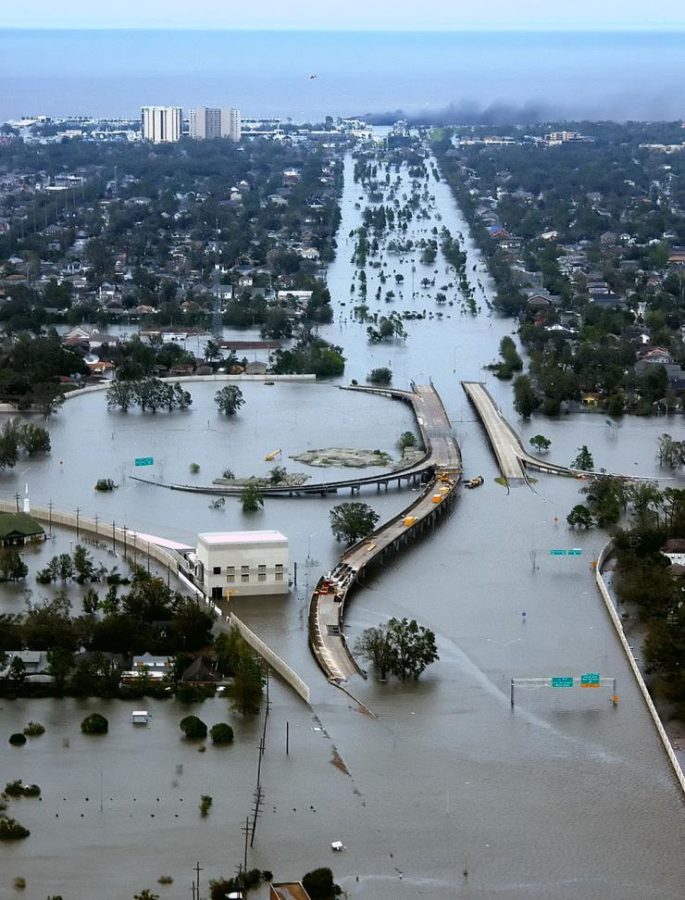Coastal flood management and the ocean–an overview:
Coastal flooding from heavy rains in New Orleans. (Image credits: “U.S. Climate Resilience Toolkit.” Coasts | U.S. Climate Resilience Toolkit, toolkit.climate.gov/topics/coastal-flood-risk.)
With the emergence of climate issues, there has been a growing issue: the presence of coastal flooding. With this comes heavy engineering and environmental conditions to take into condition. As climate change continues to grow into a larger issue, how will engineering tackle the increase of coastal flooding?
Coastal flooding is the natural occurrence of the seawater submergence of typically dry, low-lying coastal land. Although heavily natural, coastal flooding can be exacerbated by human impact and the causes for coastal flooding vary greatly. Excess groundwater extraction & groundwater pumping leading to land subsidence which increases risk for flooding. Engineered coastal walls (i.e. seawalls) alter the natural beaches they are built on, leading to coastal erosion which can be a cause for flooding. In addition, sea-level rise and extreme weather events that may be caused by climate change also lead to coastal flooding.
Climate change is one of the main driving factors for extreme weather events that push the increase of coastal flooding. With tidal (sunny day, nuisance) flooding, tidal events (especially high tides) temporarily flood low-lying coastal areas, becoming more prevalent in cities and coastal areas with human impact. This is due to the sea level rise from climate change & other human activities (erosion, land subsidence). It is predicted that in the mid-2030s the correlation between rising sea levels and the lunar cycle will cause dramatic increases in coastal flooding.
Tsunamis (large ocean waves caused by tectonic activity that lead to flooding) often send high-velocity tall waves to shore, bringing large amounts of debris that may further disrupt coastal topography. With this, we can also relate strong waves as a part of coastal flooding. Storms such as hurricanes & tropical cyclones with storm surges and heavy precipitation also bring flooding to coastal areas.
There are structures, natural and engineered, that can be used to control and alleviate the effects of coastal flooding. Topographical features, such as gravel/sand bars & dunes act as a blocker or alleviator of flooding and extreme weather events that happen in coastal areas. Mangroves & wetlands (i.e. marshes) also act as buffers to the weather, with the protection against waves, storms, and erosion. Although we cannot naturally build more sand bars or dunes, per se., we can restore the habitat loss of mangroves and marshes, which will definitely help with the issue of climate and coastal flooding. Natural defenses can also include monitoring & surveillance of natural dune systems.
Engineered structures can prevent coastal flooding, and this is done by building flood barriers, seawalls, dikes, storm-surge barriers, levees, water pumps, and overflow chambers which “armor” the beachfront, keeping water out of cities. Other artificial structures built to enhance coastal depositional processes include groynes, breakwaters, and artificial headlands, increasing sediment deposition which acts like a flooding buffer by moving sediment in the beach rather than preventing seawater movement inland. We can reduce the negative effects of land subsidence by reducing the allowing of coastal pumping, artificially recharging aquifers, and repressuring aquifers through wells. Lastly, we can observe how floods shape cities and build around that and relocate people to safer areas to prevent further consequences of flooding instead of finding ways to prevent floods; ensuring city resiliency is also another way to go with stopping the reaches of coastal flooding.
Observing the effects of climate change, human impact, and natural processes, we can find ways to prevent the effects of coastal flooding from further reaching and destroying land, property, and belongings. These methods vary from habitat restoration to structure building to establishing a plan for city resiliency.
Read More:
https://www.neefusa.org/nature/land/increases-coastal-flooding
https://www.nasa.gov/feature/jpl/study-projects-a-surge-in-coastal-flooding-starting-in-2030s
Citations:
“Coastal Flooding.” Wikipedia, Wikimedia Foundation, 10 Nov. 2021, en.wikipedia.org/wiki/Coastal_flooding#.
Dhi, et al. “Best Practices for Successful Coastal Flooding Adaptation.” Blog, 26 Mar. 2021, blog.dhigroup.com/2019/07/11/best-practices-for-successful-coastal-flooding-adaptation/.
Greicius, Tony. “Study Projects a Surge in Coastal Flooding, Starting in 2030s.” NASA, NASA, 7 July 2021, www.nasa.gov/feature/jpl/study-projects-a-surge-in-coastal-flooding-starting-in-2030s.
“Management of Coastal Flooding.” www.coastalhazardwheel.org/coastal-flooding/.
“U.S. Climate Resilience Toolkit.” Coasts | U.S. Climate Resilience Toolkit, toolkit.climate.gov/topics/coastal-flood-risk.
https://wwwrcamnl.wr.usgs.gov/rgws/Unesco/PDF-Chapters/Chapter7.pdf















